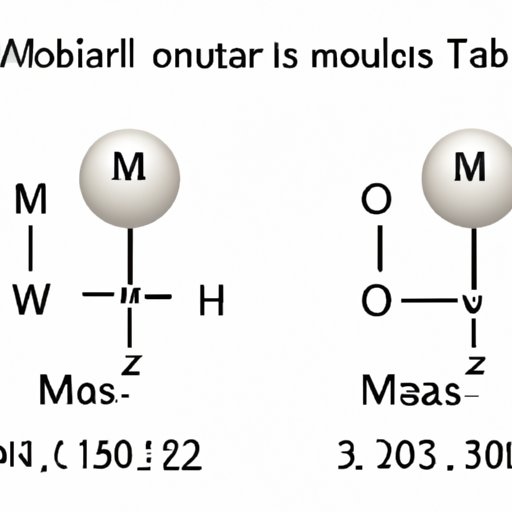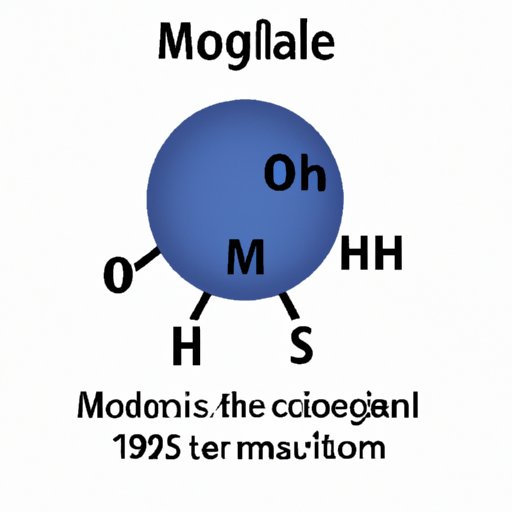I. Introduction
Many students and scientists in the field of chemistry often confuse the definitions of molecular weight and molar mass, using them interchangeably and making errors in their calculations. However, understanding the distinctions between these two concepts is crucial for accurate and successful chemistry research. The purpose of this article is to help readers understand the differences and use them correctly.
II. Understanding the Differences Between Molecular Weight and Molar Mass
A. Molecular weight refers to the sum of the atomic weights of all atoms in a given molecule. It is typically expressed in atomic mass units (amu) or grams per mole (g/mol).
B. Molar mass, on the other hand, is the mass of one mole of a substance, typically measured in grams per mole (g/mol). It is calculated by adding the atomic weights of all the atoms in a molecule.
C. The key difference between the two concepts is that molecular weight pertains to individual molecules, while molar mass pertains to the amount of a substance in moles.

III. When to Use Molecular Weight vs. Molar Mass in Chemistry Calculations
A. Molecular weight is commonly used in calculations that involve finding the weight of a molecule or converting between moles and grams.
Examples:
- Calculating the molecular weight of water (H2O):
- The atomic weight of hydrogen (H) is 1.008 amu
- The atomic weight of oxygen (O) is 15.999 amu
- Molecular weight of H2O = 2(1.008 amu) + 15.999 amu = 18.015 amu or 18.015 g/mol
- Converting 0.5 moles of sodium chloride (NaCl) to grams:
- The molar mass of NaCl is 58.44 g/mol
- 0.5 moles x 58.44 g/mol = 29.22 grams
B. Molar mass is used in calculations that involve finding the number of moles or calculating the concentrations of solutions.
Examples:
- Calculating the number of moles in 50 grams of calcium (Ca):
- The atomic weight of Ca is 40.08 g/mol
- 50 g / 40.08 g/mol = 1.25 moles
- Calculating the molarity of a solution containing 25 grams of sodium hydroxide (NaOH) in 500 mL of water:
- The molar mass of NaOH is 40.00 g/mol
- 25 g / 40.00 g/mol = 0.625 moles of NaOH
- 500 mL = 0.5 L
- Molarity = 0.625 moles / 0.5 L = 1.25 M
IV. The Importance of Knowing the Distinction Between Molecular Weight and Molar Mass
A. Knowing the difference between molecular weight and molar mass is important to avoid errors in chemistry calculations, which can result in inaccurate results and conclusions.
B. Understanding the behavior of chemical substances is also crucial in determining the right amount of a substance needed for a specific reaction or experiment.
C. Communicating ideas and findings with other scientists is also enhanced when one is familiar with the difference between these two concepts.
V. Common Confusions: Molecular Weight and Molar Mass
A. One of the most common errors in using molecular weight and molar mass is using molecular weight instead of molar mass in mole calculations. This can result in inaccurate results and errors that can lead to erroneous conclusions.
B. Another common misconception is assuming that molecular weight and molar mass are always equal. While they can be equal in certain situations for simple substances like atoms, they are not always equal for more complex substances like molecules.
C. These errors occur due to a lack of understanding of the definitions and differences of the two concepts. In some cases, students and scientists may not have sufficient knowledge of chemistry concepts in general.
VI. Comparing and Contrasting Molecular Weight and Molar Mass
A. One similarity between molecular weight and molar mass is that they both involve calculating the weight of atoms/molecules.
B. A key difference between them is that molecular weight pertains to individual molecules, while molar mass pertains to the amount of a substance in moles.
C. In order to distinguish between when to use molecular weight versus molar mass, it is important to know the end goal of the calculation: finding the weight of a molecule or converting between moles and grams for molecular weight calculations, or finding the number of moles or calculating the concentrations of solutions for molar mass calculations.
VII. Mastering the Meanings of Molecular Weight and Molar Mass in Chemistry
A. In conclusion, understanding the difference between molecular weight and molar mass is crucial for accurate and successful chemistry research. It is essential to know when to use each concept, to avoid common errors, and to enhance communication with other scientists.
B. Some tips to avoid confusion between the two concepts include practicing with sample problems, consulting textbooks and lecture notes, and seeking guidance from chemistry instructors and experts.
C. Recommended resources for further learning include chemistry textbooks, online tutorials, and practice problems.
VIII. Conclusion
A. Mastery of the concepts of molecular weight and molar mass is essential for success in chemistry research. Inaccurate results and false conclusions can arise from mistaking one for the other.
B. I encourage all readers to apply this new knowledge in their studies or research and to strive for accuracy and precision in their calculations.
